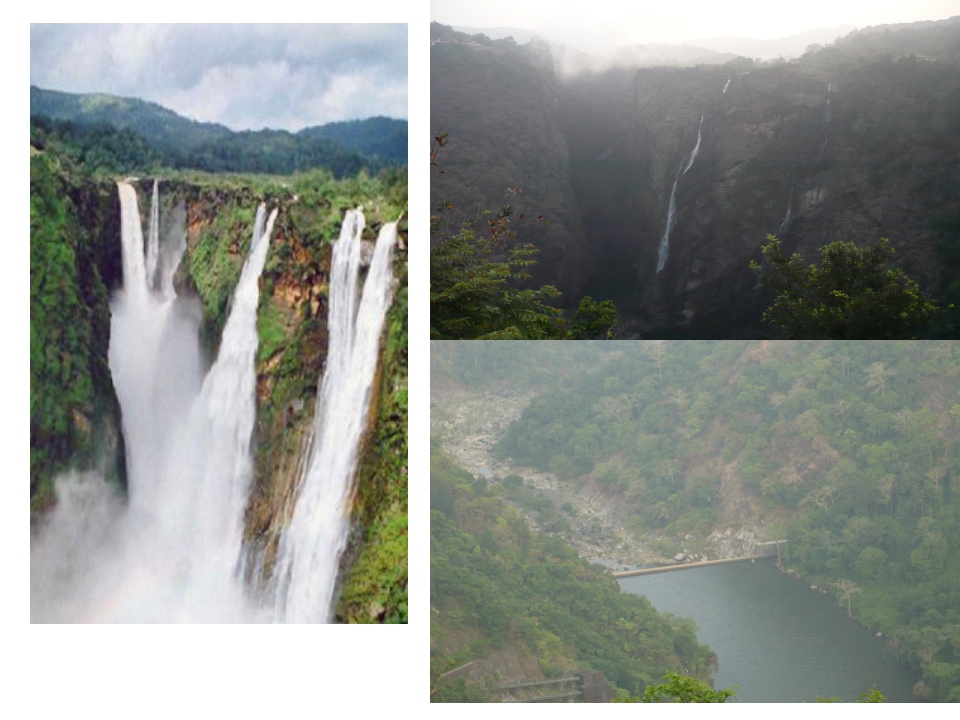What do we see our rivers as? Are they merely conduits for water that is to be used to its fullest extent? Or are they valued and revered ecosystems? The Himmotthan Society, Dehradun and International Rivers, U.S.A., hosted a discussion a workshop on ‘Environmental Flows’ at Hotel Madhuban, Dehradun on 08 June 2012 that sought to clarify the issues around these questions.
A Primer on the What, Why and How of environmental flows, authored by Dr. Latha Anantha (River Research Centre, Kerala) and Parineeta Dandekar (South Asia Network on Dams, Rivers and People, SANDRP) and published by International Rivers, was shared with the participants. The presentations made during this workshop are presented in this article.
The legendary Jog falls are a shadow of their former self after damming (Courtesy: Dr.Latha Anantha)
Overview of environmental flows:
This workshop began with a look at ths history and present status of environmental flows (e-flows) in India.Dr. Ravi Chopra of the Peoples Science Institute, Dehradun, began by examining the history of river conservation through Kashyap’s principles.

Dr. Latha Anantha explains the necessity of adequate instream flows
Why, what and how of environmental flows:
Dr. Latha Anantha examined the reasons for declining flows in rivers, and the necessity of adequate instream flows. She exhorted the participants to consider the cumulative aspect of the many interventions planned across the rivers of India.
Objective setting for environmental flows
Ms.Dandekar spoke of the various environmental flow assessment methods in vogue today. She also cautioned against accepting these numbers set by ‘experts’ as sacrosanct and against the inherent dangers of setting 'management objectives' for rivers. She suggested that free-flowing rivers and controlled rivers require separate management systems.
Environmental flows assessment for the upper Ganga
The World Wildlife Fund for Nature-India (WWF) has conducted an environmental flows assessment of the upper stretch of the Ganga. This experience was shared by Nitin Kaushal and Suresh Babu of WWF. They explained the method used, the recommendations, and the lessons learnt from that process.
Nitin Kaushal speaks about environmental flow assessment of the upper Ganga
Critique of cumulative impact assessment as done today:
Dr.Bharat Jhunjhunwala discussed the cumulative impact assessment of aquatic and terrestrial biodiversity in Alakananda and Bhagirathi basins conducted by WII. The difference between a true cumulative impact assessment that looks at the basin as a whole, and a joint report of a series of individual project reports was highlighted.
In addition to these presentations, Himanshu Thakkar of SANDRP explained that the cumulative impact of a stretch of dams is more that the sum of the impact of each dam taken singly. When impact assessments are done for individual dams, citizens lose sight of the fact that taken together, all the dams imply the death of the basins they are located in.
This workshop clarified several questions that the participants had about the concept of environmental flows. The necessity of environmental flows in rivers, the mechanics of assessment, and the policy changes necessary required to implement such ‘natural’ flow regimes were discussed. The main action points that came out of this were to actively engage in critiquing environment impact assessments, and to demystify the concept of environmental flows through study and dialogue.
Watch videos of all the talks.
Download the presentations below:
/articles/citizens-need-engage-critiquing-environment-impact-assessments-report-workshop